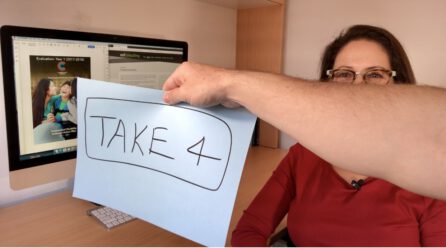 I have just launched my first in a series of online evaluation courses. This opening course is tailored to the local government sector, in which I have extensive evaluation experience. You can see it HERE and even preview the first lesson without enrolling.
I have just launched my first in a series of online evaluation courses. This opening course is tailored to the local government sector, in which I have extensive evaluation experience. You can see it HERE and even preview the first lesson without enrolling.
The whole course creation process was new to me. It was a mammoth task (many lessons took more than 4 takes!), yet it was great fun. I learned a lot, particularly these 4 things that I will take to the next courses:
1. What you’re looking for can be right under your nose
Given I would be delivering my course as short video lessons, my office setting needed to look attractive. I went to a lot of effort constructing a set in my lounge room. I made shelves, introduced props and rearranged things so that I had a clean white wall for a backdrop. After spending two weeks filming my entire course, my post-production helper came in and asked me why I didn’t use my office? My office is lovely; it has beautiful natural light, I have a fabulous long desk, and it’s my working haven. I had just thought the constructed set would look better: cleaner, slicker. He convinced me to give it a try at my desk, even though I had already shot all of the footage. It was unarguably so much better. It looked genuine. It was warmer and more friendly. So I decided to re-shoot the entire course in this new improved, existing setting. It can be viewed as two weeks wasted, or, more optimistically, two weeks spent in dress rehearsal.
The lesson here is that what you need may be right under your nose, so look at what is close by to solve problems before you look further afield.
2. Use a script
I have worked in evaluation for more than 15 years. I have a lot to convey. But to deliver that information succinctly and articulately from memory, or even from notes, can be really difficult. After shooting my first takes I realised that I would be spending most of my post-production time editing out the pauses and slip-ups.
Then I discovered the joys of the iPhone teleprompter app. I crafted well considered scripts for each video lesson rather than relying on my memory. With some practice, it is possible to deliver the lessons from the teleprompter whilst sounding natural. I have come to accept that using scripts is nothing to be ashamed of, if delivered well.
3. Keep it simple
Evaluation is a huge topic. It is impossible to cover everything, and it can be a mistake to confuse or overwhelm students with too much information. I learned that there is a sweet spot that needs to be arrived at: it’s that perfect place between simplicity and too much information.
Simple is best, as along as it is not simplistic and enough detail and examples are provided to bring it alive.
4. Enlist course reviewers
When you know your subject matter so well and you live and breath it in everyday work, it can easy to assume that students will learn and respond in the way you intended for them. But you may be surprised what you overlook. On completion of my course I enlisted the help of three well-respected colleagues to review my course. Each suggested an improvement I hadn’t considered, including adding hands-on practical exercises, simplifying some project examples, and re-wording some sections to make them clearer. Incorporating my reviewers’ suggestions improved my course.
To see an overview of the course I created, or to enrol, click here. If you work in the arts, cultural and not-for-profit sectors, I’ll be creating online evaluation training courses for you too, so stay tuned! I will be sure to incorporate these lessons into those courses and hopefully prepare them in less time!
